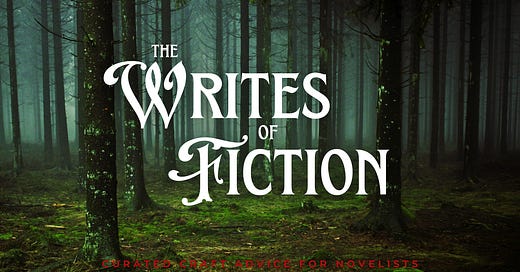Story trumps style—but style matters too
Writing techniques for novelists: first-page hooks, five common issues to tune during revision, showing and also telling, and revision strategies.
We've all felt that rush when the words just flow, when our characters take over and the story seems to write itself. This intuitive, almost magical state feels like the essence of being a writer. I get it—there's nothing quite like those moments when creativity pours through you unfiltered.
But readers don't stick around because of your beautiful sentences. They stay because they care what happens next. While you're falling in love with your prose, readers are looking for a story that grabs them, characters they connect with, and a pace that keeps them turning pages. They drop books not because the writing lacks poetry, but because they're confused, bored, or just don't care.
The most successful authors know a secret: Story trumps style every time. Behind every overnight bestseller is careful storytelling architecture—deliberate choices about revealing information, building tension, and delivering emotional payoffs. Intuition still matters (it's where your best scenes come from!), but it works hardest when channeled through storytelling structures readers can easily follow.
The real magic happens when writing and storytelling elements click together and readers lose themselves completely in your world.
In this issue of The Writes of Fiction:
First-page hooks
5 common issues to tune during revision
Showing and also telling
Fiction revision strategies
Save the Date: Office Hours on May 29
Office Hours brings writers together to chat about writing and storytelling strategies. Spend a whole hour with me and my buddy Beth Hill (The Magic of Fiction) covering your questions about writing fiction. We typically tumble into impromptu classes on the issues we’ve recently been editing, coaching, and writing about, so come discover something new about writing with us.
📅 Our next Office Hours call is Thursday, May 29 at 1:00 p.m. US Central.
Office Hours happen every other month on the last Thursday of each month at 1:00 p.m. US Central. Log-in details go out to premium members the last week of the month.
Subscribe now to join in. To upgrade your free Writes of Fiction subscription (only $8 a month—a monthly coffee date for writers!), follow these steps.
And if you’re reading this but don’t subscribe yet: Hit the green button below and choose a paid subscription.
Does your first page hook readers?
Action shows character and agency. We want to root for a character to is making a decision and that those decisions are going to have consequences. So if you open your first page with no action, you’re missing out on a chance to show who your character is by showing what they do. How they behave. Opening with action is also essential because it draws the reader into the story. Novels are boring when nothing happens. Readers read to watch things unfold real-time, to be pulled into the experience and existence of another human. So let them be a fly on the wall when something exciting—or meaningful happens.—Read the rest from Karyn Fischer at Story & Prose.
More on how your story’s structure hooks readers: Three-act structure produces a disproportionately large act in the middle of a novel—the double-stuff cream in the three-act Oreo—leaving writers with a puffy, gooey act notoriously recognized as the most difficult section to write. Act 2 of a three-act story is twice the length of the other acts, forcing writers to combat the infamous “saggy middle” effect using a hodge-podge of plot tangents and pacing tricks.
But it’s not the writing that makes the double-stuffed Act 2 feel like such a slog; it’s the structure itself. The loss of momentum is a symptom of a missing component that flattens plot and character development: the midpoint complication.—Read the rest at The midpoint complication: The missing link in three-act structure.
5 edits to strengthen your writing right now
Because often announces you’re about to infodump, tell, or drop in some backstory. In most cases, you can simply cut it and the sentence reads better, though it's usually a good idea to rethink the sentence itself. … Because is another placeholder word that highlights an opportunity for character development and world building. It's a potential moment where you can show how the point of view character sees the world around her and how she feels about it, all while imparting important information to the reader.—Read the rest from Janice Hardy at Fiction University.
More on cues for revision: a moment (or pauses, hesitations, or beats)—Instead of telling readers that moments are passing in which nothing is happening—because how dull is that?—show what’s happening within them. Those moments aren’t dead airspace; they’re dramatic potential. What happens during the moment: clocks ticking in the silence, birds lifting off from the trees? What do the characters feel and think?—Read more at Cues for revision or rewriting.
Showing and telling
We separate them out to talk about them, but in real narratives there will always be a constant shift to-and-fro between Tellishness and Showishness - which is why this stuff is always more -ish than nervous writers hoping for a definitive answer wish it was. But as with psychic distance, the shifts to and fro along the spectrum actually create a dynamism in the narrative prose which most of us miss if it’s all Tell - and actually we find just as ploddy if it’s all Show.—Keep reading from Emma Darwin at This Itch of Writing.
More on connecting the dots for readers: When you’re straining to create suspense, it’s easy to fall into withholding information—what I call Mysterioso Syndrome, the refusal to show readers what the characters are already clearly reacting to. This heavy-handed technique attempts to build dramatic tension by hiding or failing to identify the stimulus.
… In the middle of a scene, refusing to let readers see what’s making our adventurer scrabble and shout momentarily puts the story on hold. It forces readers to wait for you to finish your clever little wait-for-it moment and get out of the way so that they, too, can see whatever the character’s in such a twist about.—Keep reading Action-reaction misfires that flatten your writing.
The revision paradox: When enough is enough
Instead of revising like a caffeinated squirrel, try this:
Week 1: Tackle big picture issues –is the plot solid? Are character arcs working?
Week 2: Scene refinement –does that 12-page coffee-making scene really add value?
Week 3: Polish the language—maybe “strode” was the perfect choice after all.
Week 4: Final touches before handing it off to a professional or experienced critique partner.—Read more from Renee Fountain at Gryphon Quill.
Another approach to revision: You can call each of these steps “drafts.” You can call them “passes,” or you can call them “rounds” of revision. It doesn’t matter what you call them. What matters is that you tackle each step without getting distracted by tasks from the others.
1. The Framework Pass
2. The Story Pass
3. The Plot/Scene Pass
4. The Feedback Pass
5. The Writing Pass
6. The Tweaking Pass
While most new writers assume they’ll be spending a lot of time checking grammar and spelling, you’ll see from this list that there are more passes involving the story than there are in revising the words that tell it. Put your time and effort where it counts.—Read more in Peeling the onion: The six-layer revision plan.
Fiction Fuel
Most of us spend a lot of time censoring everything that we see and hear. Does it fit with our world picture? And if it doesn’t, how can we shut it out, how can we ignore it, how can we challenge it? We are continually threatened in life, it’s true. But once you are alone with a book, and it’s also true with a picture or with music, all those defenses drop and you can enter into a quite different space where you will learn to think differently about yourself.—Jeanette Winterson via Farnam Street
Put your effort where it counts
While most new writers assume they'll be spending a lot of time checking grammar and spelling, you'll see from this list that there are more passes involving the story than there are in revising the words that tell it. Put your time and effort where it counts! Readers will forgive an awkward sentence if they're dying to know what happens next, but they'll drop your grammatically perfect book if the story doesn't grab them.
Think of it this way: fix the foundation before painting the walls. Your creative intuition is still the star of the show—just give it some solid storytelling structure to dance on. That's how you'll transform those magical writing moments into books readers can't put down.
And isn't that the whole point?
Onward,
Lisa
Quick update! Summer slots for my Story Accelerator coaching are filling up fast. Want to bypass months of writing frustration? Grab your spot now and let's turn your creative intuition into reader-ready storytelling.
Need a quick storytelling tune-up instead? Just click here to instantly book a one-on-one consultation. No back-and-forth emails—just you, me, and solutions to your biggest writing challenges.
This is The Writes of Fiction, a slow-simmered assortment of old and new thinking about writing fiction, assembled at the desk, not by algorithm. To help keep it going, become a paid subscriber.
And this is a stolen moment of reading time with editorial assistant Bus. 👇






